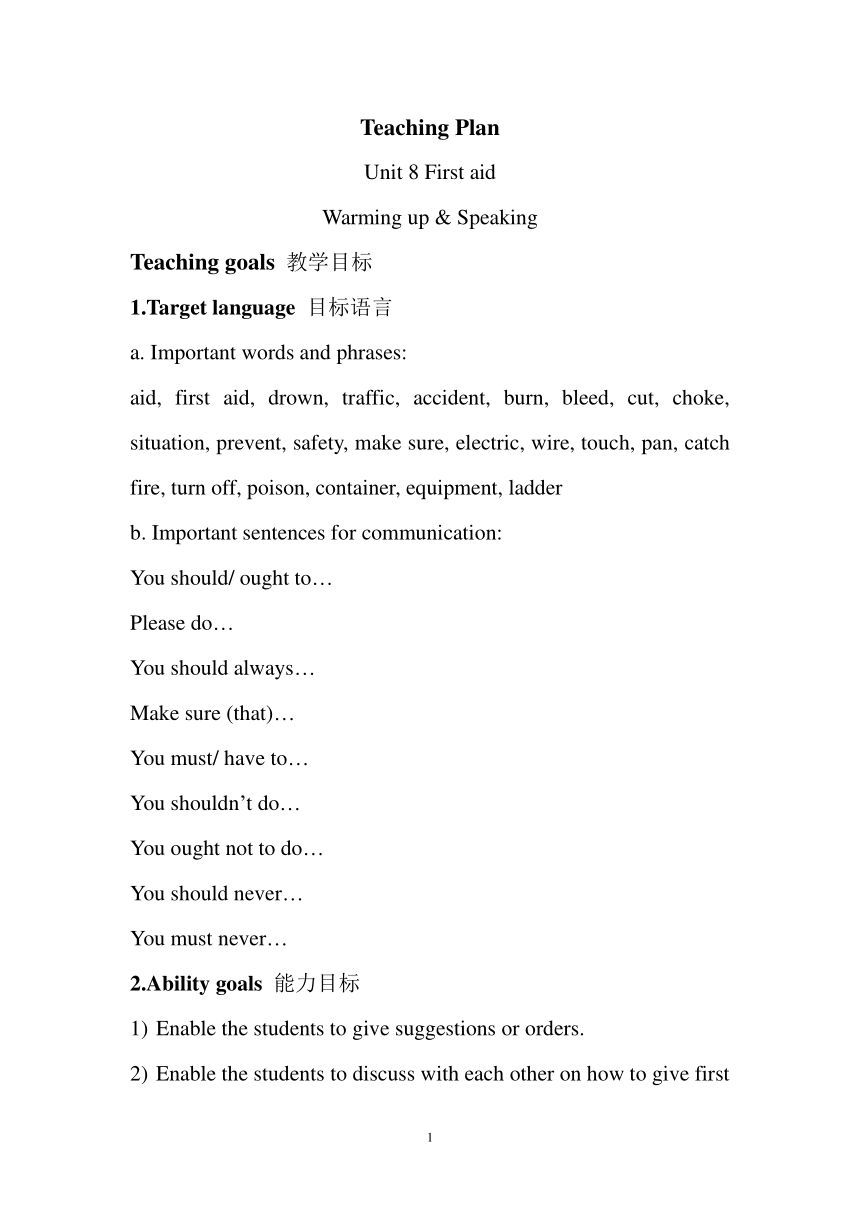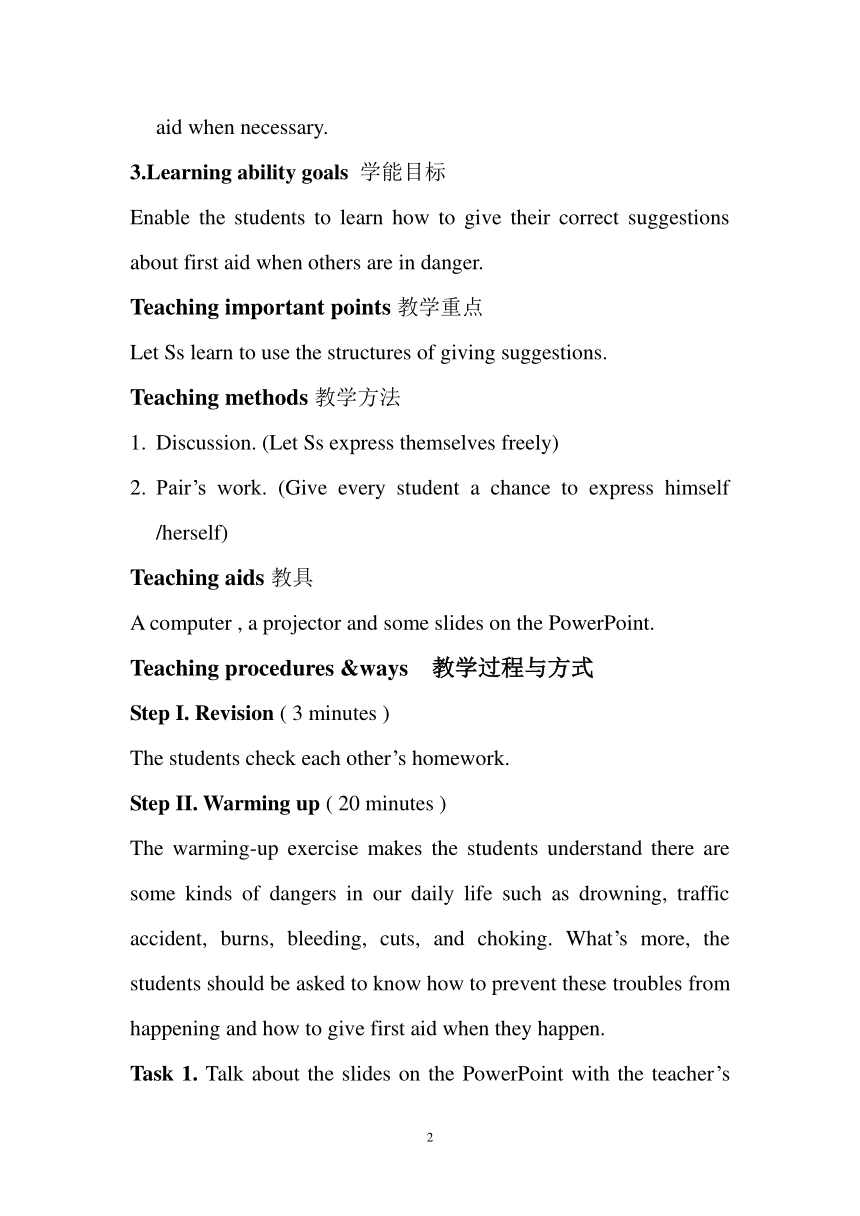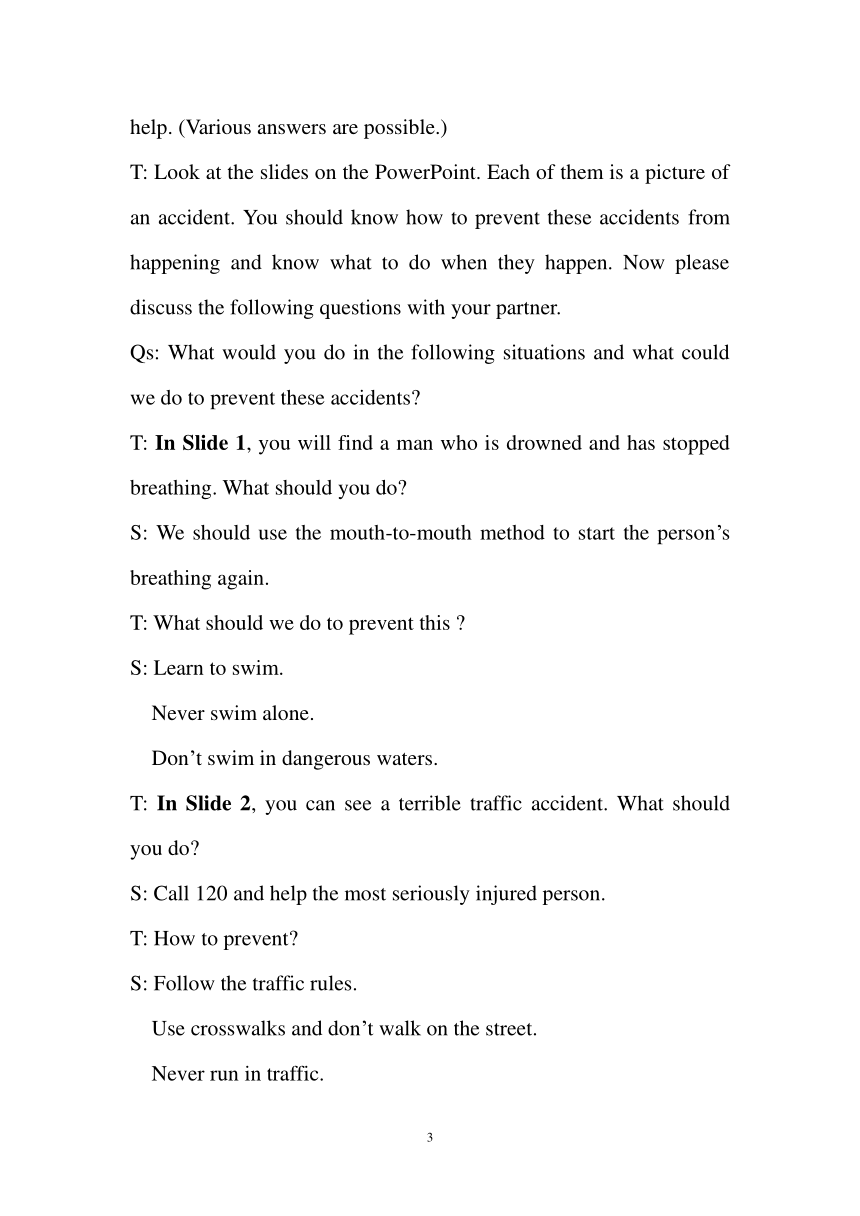高二英语Unit 8 First aid(Warming up & Speaking)教案[上学期]
文档属性
| 名称 | 高二英语Unit 8 First aid(Warming up & Speaking)教案[上学期] |  | |
| 格式 | rar | ||
| 文件大小 | 10.0KB | ||
| 资源类型 | 教案 | ||
| 版本资源 | |||
| 科目 | 英语 | ||
| 更新时间 | 2006-05-02 13:09:00 | ||
图片预览



文档简介
Teaching Plan
Unit 8 First aid
Warming up & Speaking
Teaching goals 教学目标
1.Target language 目标语言
a. Important words and phrases:
aid, first aid, drown, traffic, accident, burn, bleed, cut, choke, situation, prevent, safety, make sure, electric, wire, touch, pan, catch fire, turn off, poison, container, equipment, ladder
b. Important sentences for communication:
You should/ ought to…
Please do…
You should always…
Make sure (that)…
You must/ have to…
You shouldn’t do…
You ought not to do…
You should never…
You must never…
2.Ability goals 能力目标
1) Enable the students to give suggestions or orders.
1) Enable the students to discuss with each other on how to give first aid when necessary.
3.Learning ability goals 学能目标
Enable the students to learn how to give their correct suggestions about first aid when others are in danger.
Teaching important points教学重点
Let Ss learn to use the structures of giving suggestions.
Teaching methods教学方法
1. Discussion. (Let Ss express themselves freely)
1. Pair’s work. (Give every student a chance to express himself /herself)
Teaching aids教具
A computer , a projector and some slides on the PowerPoint.
Teaching procedures &ways 教学过程与方式
Step I. Revision ( 3 minutes )
The students check each other’s homework.
Step II. Warming up ( 20 minutes )
The warming-up exercise makes the students understand there are some kinds of dangers in our daily life such as drowning, traffic accident, burns, bleeding, cuts, and choking. What’s more, the students should be asked to know how to prevent these troubles from happening and how to give first aid when they happen.
Task 1. Talk about the slides on the PowerPoint with the teacher’s help. (Various answers are possible.)
T: Look at the slides on the PowerPoint. Each of them is a picture of an accident. You should know how to prevent these accidents from happening and know what to do when they happen. Now please discuss the following questions with your partner.
Qs: What would you do in the following situations and what could we do to prevent these accidents
T: In Slide 1, you will find a man who is drowned and has stopped breathing. What should you do
S: We should use the mouth-to-mouth method to start the person’s breathing again.
T: What should we do to prevent this
S: Learn to swim.
Never swim alone.
Don’t swim in dangerous waters.
T: In Slide 2, you can see a terrible traffic accident. What should you do
S: Call 120 and help the most seriously injured person.
T: How to prevent
S: Follow the traffic rules.
Use crosswalks and don’t walk on the street.
Never run in traffic.
In Slide 3, a house is on fire.
What would you do
Call 119 first and then 120. We shouldn't enter the house.
How to prevent
Don’t leave lamps or candles burning in your house.
Be careful when you cook.
Don’t let children touch flames or hot liquids.
In Slide 4, a person lying on the ground is bleeding.
What would you do
Try to stop the bleeding.
How to prevent
Don’t play with knives or other sharp objects.
In Slide 5, a person’s hand is cut.
What would you do
If the object is stuck in the wound, we should not remove it until we get to a doctor.
How to prevent
Don’t play with knives or other sharp objects.
In Slide 6, a man is choked when he is eating something.
What would you do
Perform the “Heimlich maneuver”. We should not slap a person’s back, which may make things worse.
Teach the students “Heimlich maneuver”. It’s done by wrapping one’s arms around the victim’s waist, then making a fist and placing the thumb side of the fist against the victim’s upper abdomen (below the ribs and above the navel). Next, one grasps one’s fist with the other hand and presses into the upper abdomen with a quick push upwards.
How to prevent
We shouldn't talk or laugh when eating.
Show the slide on the PowerPoint.
Task 2. What new words do you think will be useful when you talk about accidents and first aid (Various answers are possible.)
Step III Speaking ( 20 minutes )
PowerPoint: Safety around the house
Dos Make sure that electric wires are safe and that children can’t reach them. If a pan of oil catches fire, turn off the gas and cover the pan quickly. Make sure that everyone in your family knows how to call 110 and 120. Learn more about first aid. Don’t Don’t put poisons into other containers, for example empty bottles. Never leave small things a baby can put in its mouth on the floor or table. Don’t play with electrical equipment. Never use ladders on a wet floor.
PowerPoint: Useful expressions
Positive suggestionYou should…You ought to...Please do…You should always…Make sure that…You must …You have to… Negative suggestionYou should not…You ought not to…Please don’t…Never do…You should never…You must never…
Task 1. The students will work in pairs to tell each other about safety in the home. Encourage the students to add more safety tips.
Sample dialogue:
A: What would you like to tell me today
B: Oh, I’d like to tell you something about the safety around the house.
A: OK, I am willing to hear it.
B: First you must make sure that …
Second you should always…and you must never…
Finally please don’t…
You ought to…
A: Yeah, I see. Safety is very important, I think. Thank you!
Task 2. Work in pairs. One student acts as a mother/father who is going out and the other acts as her/his son/daughter.
Sample dialogue:
A: Tom, I’ll go to New York on business. Can you take care of yourself when I am away
B: No problem, mum. How long will you stay there
A: About two weeks. You must be careful when you are cooking. If a pan of oil catches fire, turn off the gas and cover the pan quickly.
B: I know.
A: And don’t play with electrical equipment. Do you remember
B: I have remembered all of it. Have a nice trip, mum!
Step 4. Summary ( 1 minute )
T: Now let’s recall what we have learned during this course. We have learned how to give each other suggestions. Then we have learned some useful expression for communication.
Step 5. Homework ( 1 minute )
1. Recite new words and expressions of this period. (Let the students summarize them.)
1. Preview the part of listening. (Ss listen at home.)
板书设计
Unit 8 First aid
Warming up & Speaking
Step 1. Revision
Step 2. Warming up Talk about first aid
Step 3. Speaking
Practise talking about what you should and should not do
Step 4. Summary
Step 5. Homework
PAGE
5
Unit 8 First aid
Warming up & Speaking
Teaching goals 教学目标
1.Target language 目标语言
a. Important words and phrases:
aid, first aid, drown, traffic, accident, burn, bleed, cut, choke, situation, prevent, safety, make sure, electric, wire, touch, pan, catch fire, turn off, poison, container, equipment, ladder
b. Important sentences for communication:
You should/ ought to…
Please do…
You should always…
Make sure (that)…
You must/ have to…
You shouldn’t do…
You ought not to do…
You should never…
You must never…
2.Ability goals 能力目标
1) Enable the students to give suggestions or orders.
1) Enable the students to discuss with each other on how to give first aid when necessary.
3.Learning ability goals 学能目标
Enable the students to learn how to give their correct suggestions about first aid when others are in danger.
Teaching important points教学重点
Let Ss learn to use the structures of giving suggestions.
Teaching methods教学方法
1. Discussion. (Let Ss express themselves freely)
1. Pair’s work. (Give every student a chance to express himself /herself)
Teaching aids教具
A computer , a projector and some slides on the PowerPoint.
Teaching procedures &ways 教学过程与方式
Step I. Revision ( 3 minutes )
The students check each other’s homework.
Step II. Warming up ( 20 minutes )
The warming-up exercise makes the students understand there are some kinds of dangers in our daily life such as drowning, traffic accident, burns, bleeding, cuts, and choking. What’s more, the students should be asked to know how to prevent these troubles from happening and how to give first aid when they happen.
Task 1. Talk about the slides on the PowerPoint with the teacher’s help. (Various answers are possible.)
T: Look at the slides on the PowerPoint. Each of them is a picture of an accident. You should know how to prevent these accidents from happening and know what to do when they happen. Now please discuss the following questions with your partner.
Qs: What would you do in the following situations and what could we do to prevent these accidents
T: In Slide 1, you will find a man who is drowned and has stopped breathing. What should you do
S: We should use the mouth-to-mouth method to start the person’s breathing again.
T: What should we do to prevent this
S: Learn to swim.
Never swim alone.
Don’t swim in dangerous waters.
T: In Slide 2, you can see a terrible traffic accident. What should you do
S: Call 120 and help the most seriously injured person.
T: How to prevent
S: Follow the traffic rules.
Use crosswalks and don’t walk on the street.
Never run in traffic.
In Slide 3, a house is on fire.
What would you do
Call 119 first and then 120. We shouldn't enter the house.
How to prevent
Don’t leave lamps or candles burning in your house.
Be careful when you cook.
Don’t let children touch flames or hot liquids.
In Slide 4, a person lying on the ground is bleeding.
What would you do
Try to stop the bleeding.
How to prevent
Don’t play with knives or other sharp objects.
In Slide 5, a person’s hand is cut.
What would you do
If the object is stuck in the wound, we should not remove it until we get to a doctor.
How to prevent
Don’t play with knives or other sharp objects.
In Slide 6, a man is choked when he is eating something.
What would you do
Perform the “Heimlich maneuver”. We should not slap a person’s back, which may make things worse.
Teach the students “Heimlich maneuver”. It’s done by wrapping one’s arms around the victim’s waist, then making a fist and placing the thumb side of the fist against the victim’s upper abdomen (below the ribs and above the navel). Next, one grasps one’s fist with the other hand and presses into the upper abdomen with a quick push upwards.
How to prevent
We shouldn't talk or laugh when eating.
Show the slide on the PowerPoint.
Task 2. What new words do you think will be useful when you talk about accidents and first aid (Various answers are possible.)
Step III Speaking ( 20 minutes )
PowerPoint: Safety around the house
Dos Make sure that electric wires are safe and that children can’t reach them. If a pan of oil catches fire, turn off the gas and cover the pan quickly. Make sure that everyone in your family knows how to call 110 and 120. Learn more about first aid. Don’t Don’t put poisons into other containers, for example empty bottles. Never leave small things a baby can put in its mouth on the floor or table. Don’t play with electrical equipment. Never use ladders on a wet floor.
PowerPoint: Useful expressions
Positive suggestionYou should…You ought to...Please do…You should always…Make sure that…You must …You have to… Negative suggestionYou should not…You ought not to…Please don’t…Never do…You should never…You must never…
Task 1. The students will work in pairs to tell each other about safety in the home. Encourage the students to add more safety tips.
Sample dialogue:
A: What would you like to tell me today
B: Oh, I’d like to tell you something about the safety around the house.
A: OK, I am willing to hear it.
B: First you must make sure that …
Second you should always…and you must never…
Finally please don’t…
You ought to…
A: Yeah, I see. Safety is very important, I think. Thank you!
Task 2. Work in pairs. One student acts as a mother/father who is going out and the other acts as her/his son/daughter.
Sample dialogue:
A: Tom, I’ll go to New York on business. Can you take care of yourself when I am away
B: No problem, mum. How long will you stay there
A: About two weeks. You must be careful when you are cooking. If a pan of oil catches fire, turn off the gas and cover the pan quickly.
B: I know.
A: And don’t play with electrical equipment. Do you remember
B: I have remembered all of it. Have a nice trip, mum!
Step 4. Summary ( 1 minute )
T: Now let’s recall what we have learned during this course. We have learned how to give each other suggestions. Then we have learned some useful expression for communication.
Step 5. Homework ( 1 minute )
1. Recite new words and expressions of this period. (Let the students summarize them.)
1. Preview the part of listening. (Ss listen at home.)
板书设计
Unit 8 First aid
Warming up & Speaking
Step 1. Revision
Step 2. Warming up Talk about first aid
Step 3. Speaking
Practise talking about what you should and should not do
Step 4. Summary
Step 5. Homework
PAGE
5
